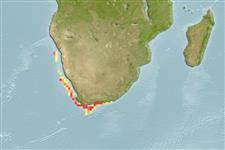Ελασμοβράγχιοι (καρχαρίες και σαλάχια) (sharks and rays) >
Torpediniformes (Electric rays) >
Torpedinidae (Electric rays)
Etymology: cowleyi: The species is named after Paul Cowley, South African Institute for Aquatic Biodiversity, in recognition of his contributions to the study of fishes in southern Africa (Ref. 100734).
Environment: milieu / climate zone / depth range / distribution range
Οικολογία
Θαλασσινό(ά) βενθοπελαγικό; εύρος βάθους 110 - 457 m (Ref. 100734). Temperate; 22°S - 37°S, 12°E - 28°E (Ref. 114953)
Southeast Atlantic: around southern Africa, from Walvis Bay, Namibia to Algoa Bay, Eastern Cape, South Africa (Ref. 100734).
Length at first maturity / Μέγεθος / Βάρος / Age
Maturity: Lm ?, range 101 - ? cm
Max length : 68.0 cm TL αρσενικό/απροσδιόριστο; (Ref. 100734); 113.3 cm TL (female)
Short description
Μορφολογία | Μορφομετρία
Diagnosis: This medium-sized torpedo ray species has a uniform shiny black to dark gray live dorsal color, and is distinguished from its most similar congeners Tetronarce nobiliana and T. puelcha by the following combination of characters: shorter spiracular length, 1.5-1.6% of total length vs. 2.6-2.8% in T. nobiliana and 2.4-3.1% in T. puelcha; a proportionally greater head length as measured between snout margin and fifth gill openings, 30.5-31.2% of total length vs. 24.7-25.8% in T. nobiliana and 26.8% in adult male T. puelcha; and a proportionally greater preoral snout length, 8.9-9.3% of total length vs. 7.4-7.6% in T. nobiliana and 6.5-8.4% in T. puelcha (Ref. 100734). It is further distinguished from T. nobiliana by its more circular anterior disc shape vs. relatively straight; fewer tooth rows, 32/28 vs. 38/38 in T. nobiliana from the North Sea and up to 53/52 in T. nobiliana from the Mediterranean; greater mouth width, 1.5-1.7 times as great as interorbital width vs. 0.5-0.6 times interorbital width; smaller distance between second dorsal and caudal fins, 3.5-4.9% vs. 6.6-6.8%; and greater clasper length in mature individuals, extending nearly to lower caudal fin origin vs. clasper extends only two-thirds the distance between second dorsal and caudal fins (Ref. 100734).
This species is mostly found along the outer continental shelf and upper slope near the bottom, but also well off it and at bottom depths of 110-457 m (Ref. 100734). Females mature by at least 100.5 cm total length and males at about 58.2 cm total length (Ref. 100734); born before 19 cm TL (Ref. 114953). Neonates reported to have been collected during pelagic plankton tows on the edge of the outer continental shelf southwest of Cape Town (Ref. 100734). The limited capture of this electric ray in bottom trawls is suspected to be not indicative of its abundance in the area, but rather by its ability to move well off the bottom while foraging for fish and other large prey; diet consists mainly of large bottom and pelagic bony fishes and small sharks (Ref. 100734).
Life cycle and mating behavior
Γεννητική Ωρίμανση | Αναπαραγωγή | Γεννοβολία | Αβγά | Γονιμότητα | Προνύμφες
Ebert, D.A., D.L. Haas and M.R. De Carvalho, 2015. Tetronarce cowleyi, sp. nov., a new species of electric ray from southern Africa (Chondrichthyes: Torpediniformes: Torpedinidae). Zootaxa 3936(2):237-250. (Ref. 100734)
IUCN Red List Status (Ref. 130435)
Threat to humans
Harmless
Human uses
αλιεία:
Περισσότερες πληροφορίες
Age/SizeΑύξησηLength-weightLength-lengthLength-frequenciesΜορφομετρίαΜορφολογίαΠρονύμφεςΔυναμική προνυμφώνΣτρατολόγησηΑφθονίαBRUVS
ΑναφορέςΥδατοκαλλιέργειεςΠροφίλ υδατοκαλλιέργειαςΣτελέχοιΓενετικήElectrophoresesΚληρονομικότηταΑσθένειεςΜεταποίησηNutrientsMass conversion
ΣυνεργάτεςΦωτογραφίεςStamps, Coins Misc.ΉχοιΣιγκουατέραΤαχύτηταΚολυμβητικός ΤύποςΕπιφάνεια βραγχίωνOtolithsΕγκέφαλοιΌραση
Εργαλεία
Special reports
Download XML
Διαδικτυακές πηγές
Estimates based on models
Phylogenetic diversity index (Ref.
82804): PD
50 = 0.5001 [Uniqueness, from 0.5 = low to 2.0 = high].
Bayesian length-weight: a=0.01479 (0.00659 - 0.03318), b=2.97 (2.78 - 3.16), in cm total length, based on LWR estimates for this (Sub)family-body shape (Ref.
93245).
Τροφικό Επίπεδο (Ref.
69278): 4.4 ±0.6 se; based on size and trophs of closest relatives
Ελαστικότητα (Ref.
120179): Πολύ χαμηλό, ελάχιστος χρόνος για διπλασιασμό πληθυσμού > 14 έτη (Preliminary K or Fecundity.).
Fishing Vulnerability (Ref.
59153): High to very high vulnerability (68 of 100).
